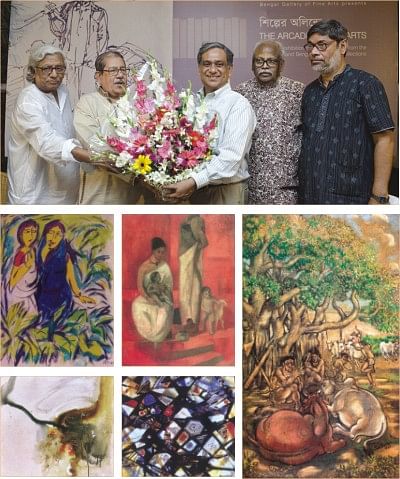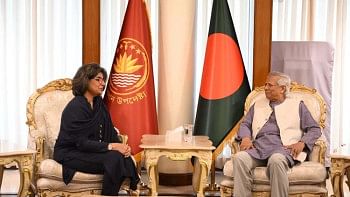Showcasing a staggering art collection

Clockwise: Dr. Anisuzzaman (2-L) and Kamal Lohani (L) greet Abul Khair (centre) with flowers on the latter’s birthday at Bengal Gallery. Artist Rafiqun Nabi (2-R) and Subir Chowdhury also seen in the picture. SM Sultan’s “Untitled”. Samarjit Roy Chowdhury’s “Untitled”. Monirul Islam’s “Sepia Love”. Quamrul Hassan’s “Dui Kanya”. Aminul Islam’s “Grihasthali”
Bengal Gallery of Fine Arts has organised an exhibition, titled “The Arcade of the Arts”, at the gallery in Dhanmondi, Dhaka. The exhibition marks the 60th birthday of Abul Khair Litu, founder and chairman of Bengal Foundation. On the opening day of the exhibition (October 7), a birthday celebration was held at the gallery premises.
The exhibition features selected artworks from the collections of Abul Khair and Bengal Foundation. Paintings by Zainul Abedin, Shafiuddin Ahmed, Quamrul Hassan, SM Sultan, Mohammad Kibria, Aminul Islam, Murtaja Baseer, Syed Jahangir, Kazi Abdul Baset, Samarjit Roy Chowdhury, Hashem Khan, Rafiqun Nabi, Monirul Islam, Mahmudul Haque, Shahid Kabir, Shahabuddin, Ranjit Das, Iftikhar Uddin Ahmed, Mohammad Iqbal and others are on display at the gallery.
Zainul Abedin played a major role in the modern art movement in Bangladesh. His works delve deep into rural people, farming, fishing, sailing boats and other panorama of untainted countryside. At the exhibition, Zainul Abedin's ink, pen and watercolour works are on display. His two sketches define working class people and two watercolours portray the simple beauty of nature in Bangladesh.
Quamrul Hassan was another significant painter of Bangladesh, recognised for retrieving our folk and traditional elements through his art. He was one of the founders of Dacca Art College. At the exhibition, “Dui Konya”, “Cattle in Moonlight”, “Three Faces” and “Nude” represent his intrigue with the Bengali female form. Curved lines and outlines of figure have enriched his works. The master artist mostly used poster colour, oil and watercolour.
Shafiuddin Ahmed always searches for perfection in his wood engravings. He has also done a number of paintings. At the exhibition, his “On the Way to the Fair” delineates a rural fair where a horse cart and a gathering of people are noticeable. Two large trees give an exquisite look to the work. Dotted and tiny lines have enriched this realistic image.
A bohemian and mystic, SM Sultan's works explore the eccentricities and norms of rural life in an unfamiliar style. His works convey a bold message in favour of the working class people. The maestro documented the marginalised community's dreams, woes and yearnings. He liked to work on large canvases, portraying many stories simultaneously. Many figures and their individual expressions have made Sultan's works remarkable. His figures are muscled and powerful, denoting a sense of prosperity -- a vision the artist had for rural Bengal. At the exhibition, his “Untitled”, an oil piece, shows some farmers resting under a banyan tree, while some seem busy with ploughing.
In Syed Jehangir's works one finds an abundance of gold and cobalt blue. They represent the land and rivers of Bangladesh. The artist, with years of successful painting behind him, had introduced the fishermen and the villagers, the farm and riverside labourers. His “Fishing at Sunset” reveals some fishermen busy at work at sunset. A half moon is noticeable in the blue sky.
In a Monirul Islam work titled “Sepia Love”, there is a remarkable interplay of sapphire, white, yellow and grey in a harmonious depiction of nature.
Mahmudul Haque's representation of nature includes emerald green, shades of chocolate brown and mauve. Dots, dashes, images -- merging into each other -- suggest the alluring nature.
Mohammad Eunus delves into pure abstract images. He frequently changes the arrangement of his form and composition.
For a while, Iftikhar Uddin Ahmed has been portraying past and present moments in his acrylic and mixed media works. His experiments with collage, form and composition provide an appealing and imposing view. Anchor, compass, doodles and adjacent columns are common features in his works. At the exhibition, his “Past and Present” reveals red, yellow and blue compositions.
Mohammad Iqbal has been painting underprivileged people, social and economical features. Subdued colours and malleable textures are the main traits in his oil- based paintings.
Kanak Chanpa Chakma's works mainly focus on hilly landscape, its people, as well as natural beauty, social and cultural atmosphere of the Chittagong Hill Tracts, where she was born and bought up. At the exhibition, her mixed media “History of Hunting” shows a man hunting in the hills. Some Bengali sentences are seen in the lower part of the painting. A large black cow is a dominant feature in the painting and the use of red is another noticeable mark.
The exhibition ends today.

 For all latest news, follow The Daily Star's Google News channel.
For all latest news, follow The Daily Star's Google News channel. 



Comments